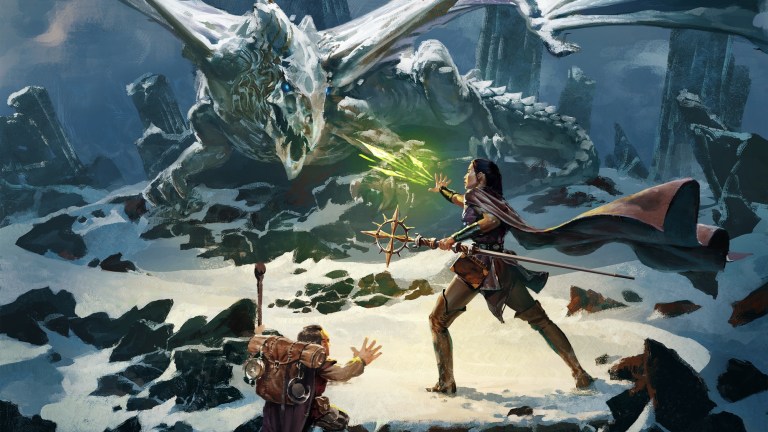Classic Dungeons & Dragons Adventures Still Worth Playing Today
To celebrate 50 years of Dungeons & Dragons, we look back at our favorite classic adventures that are still worth revisiting today!

When a Dungeons & Dragons adventure clicks, it’s a truly magical thing. This year, as long-time players and newcomers to the hobby are coming together in celebration of the 50th anniversary of rolling dice and sharing stories, it’s a great time to look back at all the adventures we’ve shared over the game’s decades-long history.
While everyone has their favorites, and game masters often write their own adventures or change the contents of published ones to fit the players at their table, there are a few undisputed classics from D&D‘s history that everyone should know. Below are seven of the most memorable Dungeons & Dragons adventures ever made that are still worth revisiting today…
Tomb of Horrors (1978)
Tomb of Horrors, written by Gary Gygax (one of the creators of Dungeons and Dragons), is one of those iconic Dungeons & Dragons adventures that was originally used for tournament play and eventually made its way to the shelves and tables all across the land. To this day, older gamers still speak of Tomb of Horrors like it was this shared traumatic experience, akin to being stuck in a cellar during a tornado or hearing a teacher tell you that a pop quiz was worth half your grade.
Even though this was a game of dice and paper, being drawn into the mouth of the green devil mosaic on the wall and finding yourself in the chamber of the evil undead wizard Acererak, one of the most well-known villains in all D&D, left its mark on countless players. This quest through the dark tomb full of monsters, traps, and obstacles, on the way to Acererak’s diabolical inner sanctum, was a great early example of how harrowing a well-put-together adventure could be.
Expedition to the Barrier Peaks (1980)
This AD&D adventure was also written by Gary Gygax and intended for characters between 8th and 12th level. This adventure is particularly memorable for its blending of high fantasy elements and science fiction, including by bringing in androids, spacecrafts, alien lifeforms, and a mysterious virus. It’s still notable today how this adventure expertly balances elements of both genres, such as a “karate master” robot and Lovecraftian monsters like the froghemoth, a giant alien frog with tentacles and three eyes.
As we made our way through the Barrier Peaks and into an odd metal cave that we eventually learned was actually a crashed spaceship, we encountered so many strange and wonderful things. Police robots, umber hulks, intellect devourers, and the towering froghemoth were just a few of the oddities discovered trying to figure out what had caused this craft to be buried in a seemingly normal mountainside.
On a very personal note, one of my favorite takeaways from this adventure was an anti-gravity belt that we found on our playthrough. While in real life, I was a kid who could not walk without the use of crutches, in game, I had always played fairly able-bodied characters. The anti-gravity belt planted the seed that if I wanted to, I could play a hero who felt a little more representative of myself. The belt was not labeled as an accessibility aid, but it got the wheels turning, and after home brewing a magical power source (so we did not have to rely on the power discs we found in the dungeon), that small item helped me realize just how powerful D&D could be. It changed the landscape of gaming for me as a player, a storyteller, and eventually a professional game designer.
Castle Amber (1981)
Castle Amber, also known as Château ď Amberville, was created by Tom Moldvay. Partly based on the Averoigne stories of weird fiction writer Clark Ashton Smith, as well as the works of Edgar Allan Poe and Roger Zelazny, this was a fun low-level adventure designed for a larger party. You see, while a typical D&D game usually consists of four or five players and a storyteller, Castle Amber was set to accommodate upwards of 10 players at the table. In fact, we usually played it with 12. That might sound a little crowded, but this adventure is so trying that you end up needing all hands to navigate its many threats.
Castle Amber starts off with us setting up camp on a hillside, feeding our troop of donkeys, and falling asleep, only to find ourselves—through the twisted threads of magic—waking up in the foyer of the titular castle. The doors to the castle were open, and beyond were mists that obscured all visibility. Things got more worrying when we realized one of the donkeys had wandered into the mist and died under mysterious circumstances. The storyteller provided no information other than that it seemed the poor animal had been in horrible pain before its death; immediately, a table full of players were terrified of this grey, cloudy substance surrounding the structure. But we should have been even more terrified of the Brain Collectors, spider-like horrors whose bodies were partially made up of the brains of its victims…
Ravenloft (1983)
Ravenloft, written by Tracy and Laura Hickman, was my first real introduction to the concept of a “Big Bag Villain” (commonly known as the BBG). Around the age of 12, I was invited to join a party that was already a few sessions into this Gothic horror adventure. The party was on a quest to rid these strange gray lands of the oppressive vampire lord who had it under his heel. First leaving the witch’s haunted woods behind, we then continued our journey through the Dracula-inspired castle Ravenloft, home of the iconic vampire lord Strahd von Zarovich.
The story was so rich and vivid, full of unknowable evil, homages to horror classics like Mary Shelley’s Frankenstein, and many terrifying monsters, all fitting perfectly to create an adventure laced with mystery and dread. We were constantly on the edge of our seats, worried that Lord Strahd would appear at any second and cut us all down. In other words, this adventure’s absolutely perfect for horror fans who want a story with some edge.
The War Rafts of Kron (1984)
Written by Bruce Nesmith with an amazing cover by Larry Elmore, this Advanced Dungeons & Dragons (AD&D) adventure was designed for a higher-level party of 4-6 players and was set above and below the sea, providing a ton of opportunities for oceanic and undersea wilderness exploration, including to the underwater city of Colhador. Player characters were sent out to rescue a missing princess and discover who orchestrated attacks on local merchant ships and found themselves dealing with all manner of undersea creatures, including water elementals, crystal guardians who were virtually invisible underwater, and more weresharks than any party would be comfortable with.
One of the most memorable moments for my party came when we found ourselves entering an empty room, save for this weird monster sitting in the center. This thing had four red eyes, tentacles that sprouted from its back, and a mouth full of sharp teeth. To look upon this creature was to know fear, and we kept running away from it time and time again, worried it would destroy us in some worrying way. It took us hours to realize the thing was an illusion, and the results of that revelation became a part of our gaming going forward.
The best adventures are like that: they leave an impression on you, even if it’s a bunch of kids screaming “I choose to disbelieve” whenever we came up against anything remotely worrying.
The Temple of Elemental Evil (1985)
Written by Gary Gygax and Frank Mentzer, The Temple of Elemental Evil gave us all a chance to stretch our roleplaying muscles as we were dropped into the village of Hommlet with basic gear, very little coin, and the promise of adventure and fame. The adventure focuses on stopping roaming bandits and reassuring worried villagers that the bad old days they experienced years before were not making a comeback.
We, of course, could not be more wrong, as the adventure led us to uncover all sorts of villains hiding within the quiet little town. Once we dealt with those, we were off to the thief-infested village of Nulb and the Temple of Elemental Evil beyond. The temple itself was so large that even playing for five or six hours at a time, it took us months to explore, often getting destroyed by the various temple denizens and having to make new characters to try the whole thing over again. Finally, after fighting through oozes, jellies, and puddings, we clashed with the forces of the Demon Queen of Fungi Zuggtmoy, various elemental-themed enemies, and even the Demigod Iuz.
Queen of the Spiders (1986)
Designed by Gary Gygax and David C. Sutherland, Queen of the Spiders is an adventure that begins with your party being called upon to protect the lands from Giant raiders but soon sees you exploring hidden places deep below the earth as well as get into all sorts of trouble in the great Drow city of Erelhei-Cinlu.
To this day, there are still so many warm memories wrapped up in running this adventure, from wererats and mind flayers to the men-fish known as Kuo-Toa and cave trolls. My party spent months wandering through the subterranean landscape, then finally entering the Demonweb Pits and confronting Lolth the Demon Queen of Spiders. Along the way, we ventured through the strangest corners of the Greyhawk setting, with spellbooks in hand and slaying every creature we could find.
What are your favorite Dungeons & Dragons adventures? Let us know in the comments!
